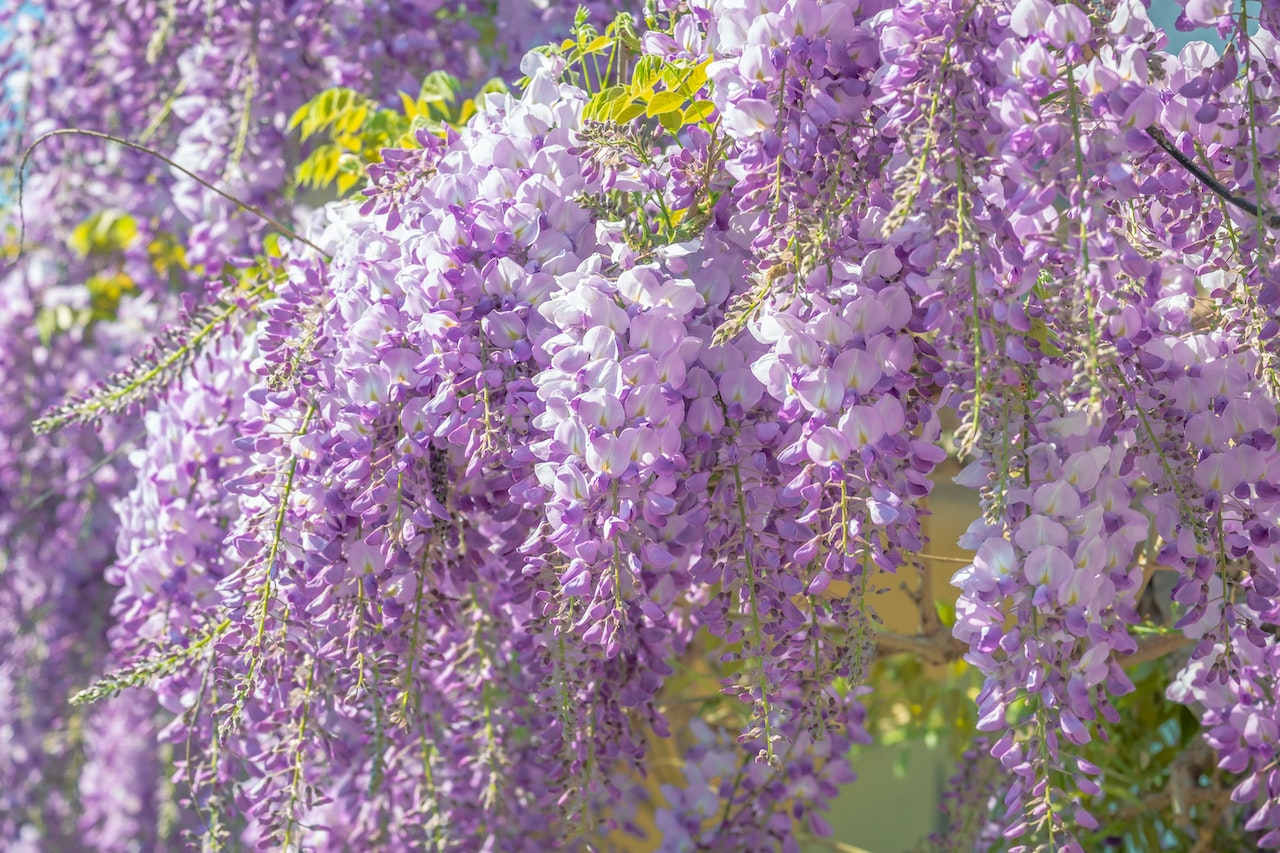Meaning Of Wisteria - A Symbolic Flower Of Beauty And Mystery
Wisteria, a beautiful flowering plant with cascading clusters of purple, blue, pink, or white blooms, has been revered for centuries for its beauty and symbolic significance. In this article, we explore the meaning of wisteria and its cultural significance in different parts of the world.
Author:Suleman ShahReviewer:Han JuJun 01, 20231.1K Shares138.7K Views

Wisteria, a beautiful flowering plant with cascading clusters of purple, blue, pink, or white blooms, has been revered for centuries for its beauty and symbolic significance. In this article, we explore the meaning of wisteriaand its cultural significance in different parts of the world.
The Botanical Characteristics Of Wisteria
Before we delve into the symbolic meaning of wisteria, it is essential to understand its botanical characteristics. Wisteria is a deciduous climbing vine that belongs to the pea family, Fabaceae.
It is native to Asia and North America and is widely cultivated as an ornamental plant in gardens and parks. The most common varieties of wisteria are Chinese wisteria (Wisteria sinensis) and Japanese wisteria (Wisteria floribunda).
The Growth Habits Of Wisteria
Wisteria is a climbing vine that can reach up to 10 meters in height and spread up to 20 meters wide. It is a fast-growing plant, and its woody stems can become quite thick with age.
Wisteria vines are strong and can easily climb walls, trellises, and other structures with the help of their twining stems. The plant produces tendrils that curl around surfaces, allowing it to climb vertically.
The Colors Of Wisteria Flowers
Wisteria flowers are known for their striking colors, ranging from lavender and purple to white, pink, and blue.
The flowers grow in large, drooping clusters that can be up to 30cm long, making them a stunning sight to behold. Different varieties of wisteria have different flower colors, and some even have bi-colored flowers.
The Fragrance Of Wisteria Flowers
Wisteria flowers are known for their intense, sweet fragrance. The scent is produced by the plant's nectar and is highly attractive to bees, butterflies, and other pollinators.
Wisteria's fragrance is often compared to that of grape soda or honey, and it can be smelled from a distance.
The Leaves Of Wisteria Plants
Wisteria leaves are pinnate, which means they have leaflets arranged on either side of the stem, giving them a feather-like appearance. The leaves can be up to 30cm long and are bright green in color. They are typically deciduous, which means they fall off the plant in the autumn and winter.
The Seed Pods Of Wisteria Plants
After the wisteria blooms, it produces long, slender seed pods that can reach up to 15cm in length. The seed pods are usually brown and woody and contain several seeds. Wisteria seed pods are not edible and can be toxic if ingested, so it is essential to keep them away from children and pets.
Meaning Of Wisteria And Spiritual Meaning
In Japanese culture, wisteria has a special spiritual meaning and is highly revered. The flower is associated with elegance, sensitivity, and grace, and it is often used in traditional Japanese art and literature. In Japanese mythology, the wisteria flower represents love, sensuality, and perseverance.
Wisteria And Spirituality In Feng Shui
In Feng Shui, wisteria is believed to have powerful spiritual properties. It is considered to be a symbol of spiritual growth, transformation, and enlightenment.
Placing a wisteria plant or artwork depicting wisteria in the home is said to bring positive energy and promote spiritual balance and harmony.
The Spiritual Significance Of Wisteria In Christian Tradition
In Christian tradition, wisteria is often associated with the Virgin Mary and is considered a symbol of purity, humility, and devotion.
The flower's drooping clusters are said to resemble the tears shed by the Virgin Mary during the crucifixion of Jesus Christ. Wisteria is also used in Christian art and architecture as a decorative motif, representing the beauty and grace of the divine.
Wisteria In Native American Spirituality
In Native American spirituality, wisteria is considered a symbol of the cycles of lifeand death. The plant's growth habits, with its old vines dying off and new growth taking their place, are seen as a metaphor for the process of reincarnation and rebirth.
Wisteria is also associated with healing and is used in traditional Native American medicine to treat a variety of ailments.
The Symbolism Of Wisteria In Chinese Culture
In Chinese culture, wisteria is a symbol of good luck, wealth, and prosperity. It is often used in traditional Chinese art and literature as a decorative motif, and it is believed to bring good fortune to those who possess it.
In Chinese mythology, the wisteria flower represents the essence of romance and is associated with love, fidelity, and devotion.
Wisteria And The Chakra System
In the Chakra system, wisteria is associated with the Crown Chakra, which is located at the top of the head and is associated with spiritual awakeningand enlightenment.
The purple color of wisteria flowers is said to correspond with the Crown Chakra, and the plant is believed to have a purifying and energizing effect on this energy center.
Red Wisteria Flower Meaning
While most wisteria flowers are purple or white, there are some varieties that produce red blooms. Red wisteria flowers are highly prized for their unique color and are often associated with love, passion, and desire.
Red Wisteria And Romantic Love
Red wisteria flowers are often used in weddings and other romantic events, as they are believed to symbolize deep and passionate love.
In floral arrangements, red wisteria can be combined with other red flowers, such as roses or carnations, to create a stunning display that conveys feelings of love and desire.
Red Wisteria In Chinese Culture
In Chinese culture, red is a highly auspicious color that is associated with good luck, wealth, and prosperity.
Red wisteria flowers are often used in traditional Chinese art and literature as a decorative motif, and they are believed to bring good fortune to those who possess them.
Red Wisteria And Spiritual Awakening
In spiritual circles, red wisteria flowers are sometimes associated with the process of spiritual awakening and enlightenment.
The fiery red color of these flowers is said to represent the intense energy and passion that can arise during the spiritual journey.
Red wisteria is often used in meditation and other spiritual practicesto help cultivate a sense of inner strength and vitality.
Red Wisteria And Creativity
Red wisteria flowers are also believed to have a positive effect on creativity and inspiration. The vibrant red color of these flowers is said to stimulate the imagination and promote a sense of passion and energy.
Artists, writers, and other creative individuals may find that having red wisteria flowers in their workspace helps to boost their creativity and productivity.
Red Wisteria And Healing
In some traditional medicine systems, red wisteria flowers are used to treat a variety of ailments, including digestive issues, skin problems, and respiratory conditions.
The flowers are believed to have anti-inflammatory and antioxidant properties, and they may also help to stimulate the immune systemand promote overall wellness.
Wisteria Biblical Meaning
Wisteria is not specifically mentioned in the Bible, but there are several passages that refer to vines, which Wisteria is a member of.
The symbolism of vines in the Bible can be applied to wisteria, and there are some interpretations of biblical verses that are associated with wisteria.
The Vine In The Bible
The vine is mentioned many times in the Bible, and it often symbolizes abundance, prosperity, and fertility. In John 15:5, Jesus says, "I am the vine, you are the branches.
If you remain in me and I in you, you will bear much fruit; apart from me, you can do nothing." This passage is often interpreted to mean that only through a strong connection with God can one achieve spiritual abundance and growth.
Wisteria And The Tree Of Life
In the book of Genesis, the Tree of 11111 is mentioned as a symbol of eternal life and spiritual nourishment. Some interpretations suggest that wisteria, with its twisting and winding vines, can be seen as a representation of the Tree of Life.
The fragrant and beautiful blooms of wisteria can be seen as a metaphor for the spiritual nourishment that one can receive from a connection with God.
The Vineyard In The Bible
In several biblical passages, vineyards are described as symbols of wealth, prosperity, and abundance. In Isaiah 5:7, for example, God is portrayed as a vineyard owner who carefully tends to his vines but is disappointed when they do not produce good fruit.
This passage is often interpreted to mean that God expects his people to use their talents and resources wisely and to bear fruit in their lives.
The Symbolism Of Grapes
Grapes are often used in the Bible as a symbol of abundance and blessings. In Deuteronomy 8:8, the land of Israel is described as a "land of wheat and barley, of vines and fig trees and pomegranates, a land of olive oil and honey." This passage suggests that grapes, like other fruits of the land, are a symbol of God's blessings and provision.

What is the meaning of the word WISTERIA?
Wisteria And Spiritual Growth
While wisteria may not have a specific biblical meaning, its symbolism as a vine can be applied to spiritual growth and connection with God.
Just as a vine needs to be rooted in the soil and receive nourishment in order to grow and bear fruit, so too must individuals be rooted in their faith and cultivate a connection with God in order to grow spiritually.
The twisting and winding vines of wisteria can serve as a reminder of the importance of staying connected to God and nourishing one's spiritual growth.
People Also Ask
What Is The Cultural Significance Of Wisteria In Japan?
In Japan, wisteria is associated with nobility and wealth and is often featured in traditional Japanese art and architecture.
What Does The Color Of Wisteria Flowers Symbolize?
The color of wisteria flowers can vary, but in general, they are associated with themes of femininity, grace, and elegance.
What Does Wisteria Symbolize In The Language Of Flowers?
Wisteria is often seen as a symbol of devotion, love, and longing.
How Does The Meaning Of Wisteria Vary Across Different Cultures?
The meaning of wisteria can vary significantly across different cultures, with interpretations ranging from themes of love and sensuality to new beginnings and spiritual growth.
What Is The Connection Between Wisteria And The Concept Of Rebirth?
Some cultures view wisteria as a symbol of rebirthand regeneration, due to its ability to grow and thrive even in harsh conditions.
Conclusion
Wisteria is a plant that holds many symbolic meanings across various cultures and contexts. From its association with love and sensuality to its symbolism of new beginnings and spiritual growth, wisteria is a flower that holds a deep and complex meaning.
Whether viewed as a symbol of beauty and elegance or as a reminder of the importance of staying rooted in one's faith, the meaning of wisteria is multi-faceted and can hold different significance for different people.
Regardless of the interpretation, the beauty and allure of wisteria continue to captivate and inspire, making it a beloved flower with a timeless appeal.

Suleman Shah
Author
Suleman Shah is a researcher and freelance writer. As a researcher, he has worked with MNS University of Agriculture, Multan (Pakistan) and Texas A & M University (USA). He regularly writes science articles and blogs for science news website immersse.com and open access publishers OA Publishing London and Scientific Times. He loves to keep himself updated on scientific developments and convert these developments into everyday language to update the readers about the developments in the scientific era. His primary research focus is Plant sciences, and he contributed to this field by publishing his research in scientific journals and presenting his work at many Conferences.
Shah graduated from the University of Agriculture Faisalabad (Pakistan) and started his professional carrier with Jaffer Agro Services and later with the Agriculture Department of the Government of Pakistan. His research interest compelled and attracted him to proceed with his carrier in Plant sciences research. So, he started his Ph.D. in Soil Science at MNS University of Agriculture Multan (Pakistan). Later, he started working as a visiting scholar with Texas A&M University (USA).
Shah’s experience with big Open Excess publishers like Springers, Frontiers, MDPI, etc., testified to his belief in Open Access as a barrier-removing mechanism between researchers and the readers of their research. Shah believes that Open Access is revolutionizing the publication process and benefitting research in all fields.

Han Ju
Reviewer
Hello! I'm Han Ju, the heart behind World Wide Journals. My life is a unique tapestry woven from the threads of news, spirituality, and science, enriched by melodies from my guitar. Raised amidst tales of the ancient and the arcane, I developed a keen eye for the stories that truly matter. Through my work, I seek to bridge the seen with the unseen, marrying the rigor of science with the depth of spirituality.
Each article at World Wide Journals is a piece of this ongoing quest, blending analysis with personal reflection. Whether exploring quantum frontiers or strumming chords under the stars, my aim is to inspire and provoke thought, inviting you into a world where every discovery is a note in the grand symphony of existence.
Welcome aboard this journey of insight and exploration, where curiosity leads and music guides.
Latest Articles
Popular Articles
